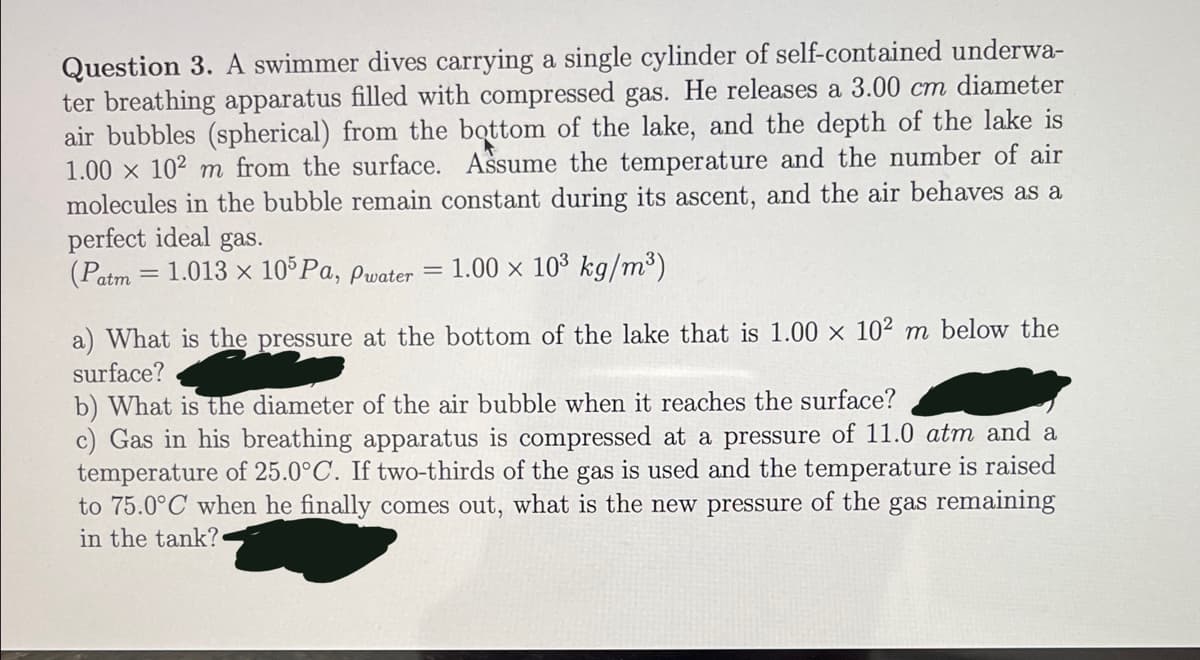Question 3. A swimmer dives carrying a single cylinder of self-contained underwa- ter breathing apparatus filled with compressed gas. He releases a 3.00 cm diameter air bubbles (spherical) from the bottom of the lake, and the depth of the lake is 1.00 x 102 m from the surface. Assume the temperature and the number of air molecules in the bubble remain constant during its ascent, and the air behaves as a perfect ideal gas. (Patm = 1.013 x 10°Pa, pwater = 1.00 x 10° kg/m³) a) What is the pressure at the bottom of the lake that is 1.00 x 10² m below the surface? b) What is the diameter of the air bubble when it reaches the surface? c) Gas in his breathing apparatus is compressed at a pressure of 11.0 atm and a temperature of 25.0°C. If two-thirds of the gas is used and the temperature is raised to 75.0°C when he finally comes out, what is the new pressure of the gas remaining in the tank?
Question 3. A swimmer dives carrying a single cylinder of self-contained underwa- ter breathing apparatus filled with compressed gas. He releases a 3.00 cm diameter air bubbles (spherical) from the bottom of the lake, and the depth of the lake is 1.00 x 102 m from the surface. Assume the temperature and the number of air molecules in the bubble remain constant during its ascent, and the air behaves as a perfect ideal gas. (Patm = 1.013 x 10°Pa, pwater = 1.00 x 10° kg/m³) a) What is the pressure at the bottom of the lake that is 1.00 x 10² m below the surface? b) What is the diameter of the air bubble when it reaches the surface? c) Gas in his breathing apparatus is compressed at a pressure of 11.0 atm and a temperature of 25.0°C. If two-thirds of the gas is used and the temperature is raised to 75.0°C when he finally comes out, what is the new pressure of the gas remaining in the tank?
Physics for Scientists and Engineers, Technology Update (No access codes included)
9th Edition
ISBN:9781305116399
Author:Raymond A. Serway, John W. Jewett
Publisher:Raymond A. Serway, John W. Jewett
Chapter21: The Kinetic Theory Of Gases
Section: Chapter Questions
Problem 21.8OQ
Related questions
Question

Transcribed Image Text:Question 3. A swimmer dives carrying a single cylinder of self-contained underwa-
ter breathing apparatus filled with compressed gas. He releases a 3.00 cm diameter
air bubbles (spherical) from the bottom of the lake, and the depth of the lake is
1.00 x 102 m from the surface. Assume the temperature and the number of air
molecules in the bubble remain constant during its ascent, and the air behaves as a
perfect ideal gas.
(Patm = 1.013 x 10 Pa, pwater = 1.00 x 103 kg/m³)
a) What is the pressure at the bottom of the lake that is 1.00 x 10² m below the
surface?
b) What is the diameter of the air bubble when it reaches the surface?
c) Gas in his breathing apparatus is compressed at a pressure of 11.0 atm and a
temperature of 25.0°C. If two-thirds of the gas is used and the temperature is raised
to 75.0°C when he finally comes out, what is the new pressure of the gas remaining
in the tank?
Expert Solution
This question has been solved!
Explore an expertly crafted, step-by-step solution for a thorough understanding of key concepts.
Step by step
Solved in 3 steps

Knowledge Booster
Learn more about
Need a deep-dive on the concept behind this application? Look no further. Learn more about this topic, physics and related others by exploring similar questions and additional content below.Recommended textbooks for you

Physics for Scientists and Engineers, Technology …
Physics
ISBN:
9781305116399
Author:
Raymond A. Serway, John W. Jewett
Publisher:
Cengage Learning

Principles of Physics: A Calculus-Based Text
Physics
ISBN:
9781133104261
Author:
Raymond A. Serway, John W. Jewett
Publisher:
Cengage Learning


Physics for Scientists and Engineers, Technology …
Physics
ISBN:
9781305116399
Author:
Raymond A. Serway, John W. Jewett
Publisher:
Cengage Learning

Principles of Physics: A Calculus-Based Text
Physics
ISBN:
9781133104261
Author:
Raymond A. Serway, John W. Jewett
Publisher:
Cengage Learning
